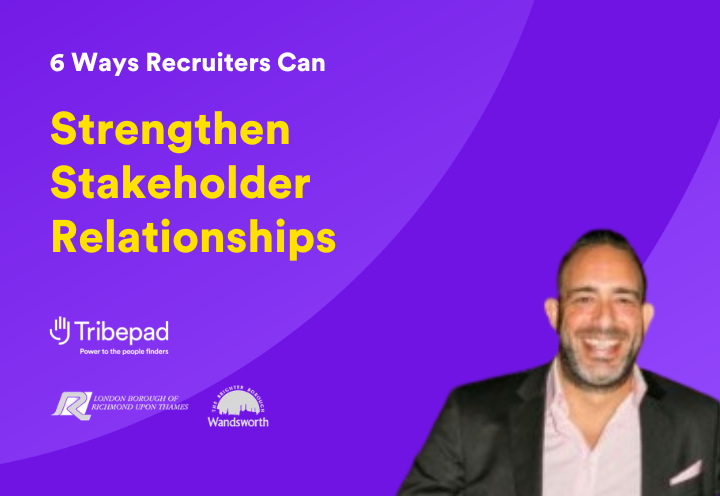As an internal recruiter for a small business, stakeholder management skills are everything. The strength of your internal relationships can make the difference between roaring success and a role you love and – not. Lacklustre results and anxious Sunday nights. We spoke to Recruiting Brainfood’s Hung Lee about the knotty topic of stakeholder management. Keep reading for our panellists’ top tips.
The final session of our four-part webinar series with Recruiting Brainfood’s Hung Lee focusses on something that can be a big challenge for recruiters. Especially recruiters in growing businesses where the value and impact of recruitment hasn’t been established yet.
We’re talking about… stakeholder management.
We were joined by the fabulous Grace Carey, Senior Talent Acquisition Partner for Lightspeed, and Gita Selli, Talent Acquisition Manager for Loadsmart to discuss this meaty topic. Let’s dive straight in.
How is stakeholder management different in-house?
Hung’s spoken often about the shift from agency to in-house recruitment, which he reckons accounts for some 80% of internal recruiters’ career path. Both Gita and Grace followed that well-trodden route and called out three main differences:
1 – You’re more accountable
“When you’re in-house, there’s no hiding”, says Grace. “It can be quite confronting because suddenly the buck stops with you. The company aren’t working with three other suppliers.”
Gita adds: “Agency-side, you might sometimes make the wrong hire but you still get paid. When you’re in-house, the magnifying glass is completely on you after candidates are hired. And nobody gets it right all the time. You have to be able to learn from mistakes.”
2 – You’re more involved
As an agency recruiter you typically have a diverse desk juggling multiple clients, Grace points out. “You’re invested in your clients, but you can’t spend your whole day with one person. Whereas when you move in-house, you have to shift your approach and zone into one organisation’s objectives and processes.”
In-house recruiters are more tightly involved with the business. In growing organisations especially, you typically have enormous end-to-end oversight over the entire recruitment process.
3 – You have more influence
Yes, in-house recruiters are more involved and more accountable for longer-term results than agency recruiters—but this closeness also affords you more influence.
In-house recruiters work alongside decision-makers, ultimately with the same goals. You’re (hopefully) partners, pulling in the same direction. It’s exactly this that’s attractive to most in-house talent folks we know, because it means you can have a bigger impact.
So – that’s the landscape you’re navigating. Let’s talk about some suggestions to help you improve stakeholder management.
Tips for SME recruiters to improve stakeholder management
Understand the bigger picture
The start of great stakeholder management is empathy. Gita emphasises the importance of getting under stakeholders’ skin, to understand what matters to them and why.
“You have to speak their language to get a seat at the table”, she says. “What are their hopes and dreams, and what role does recruitment play?”
Grace also underlines the importance of developing a sense of perspective, to prioritise what’s right for the business:
“If you’ve come from an agency recruitment background, you’re probably laser-focussed on your own targets and own performance. But often as an internal recruiter, the right decision for the business is separate from your personal goals. You have to put yourself in the business’ shoes.”
When stakeholders understand that you understand what matters to them, and you’re on the same team, you’ll find it much easier to build a partnership.
Listen for the first 30-days (at least)
You won’t understand the bigger picture unless you spend lots of time listening, our panellists unanimously agree. Active listening is an enormous part of stakeholder management.
And one of hiring managers’ biggest bugbears is that recruiters don’t properly understand the role they’re hiring for. That’s an easy one to counter by listening, listening, listening.
Hung emphasises the importance of observing before you dive into operational changes, to build a complete picture of what’s happening. Be nosey and sit into as many parts of the process as possible before you leap into any changes.
You need to understand the whole recruitment machine before you start recommending tweaks.
Test and learn – don’t reinvent the wheel
By the same token, stakeholder management typically goes more smoothly if you introduce incremental changes and take people along for the ride.
“People can be a bit nervous and protective of the things they’ve built”, Grace points out. Hung empathically agrees:
“Sometimes you’ll see obvious errors or inefficiencies in the recruiting process but remember someone in the business built this. Someone invested huge amounts of time into this. There can be a real emotional attachment that creates resistance, especially if you come in and trash everything they’ve done.”
Look for opportunities to make little, high-impact tweaks here and there, to build your credibility and profile before rolling-out more major changes. It takes time to build the trust and buy-in to accept your changes: don’t bulldoze.
Set and manage expectations upfront
Gita talks about the importance of setting yourself clear 30, 60, and 90-day targets when you come into a business – especially if you’re the first recruitment hire. And communicating those clearly outwards, so everyone knows what your role will be.
Stakeholder management is often complicated by the fact that stakeholders don’t actually know what recruitment is meant to do.
But Hung points out, it’s crucial not to overpromise because it’ll erode trust. Be clear about what you can and can’t achieve.
Send regular, personalised recruitment reports
One brilliant stakeholder management technique Gita mentions is around recruitment reporting. She has virtual coffee breaks with her stakeholders and makes sure she understands:
- What does each stakeholder expect from recruitment?
- What metrics or KPIs are relevant for each stakeholder?
- What metrics or KPIs aren’t relevant for each stakeholder?
- How regularly does each stakeholder want to see reports?
Then she builds personalised recruitment reports for different stakeholders, automatically delivered to them on the cadence that makes sense for them.
But that alone isn’t enough, she cautions. You’ll also need to continually beat the recruitment reporting drum:
- Ask stakeholders for thoughts
- Remind them where they can find reports
- Check-in whether they want any different info
Great stakeholder management comes when you’re making recruitment super visible and pre-empting what stakeholders care about, with reliable, consistent, transparent reports.
Meet managers where they are
“Remember that you’re working to the level of each hiring manager”, Grace adds. “Some hiring managers are instantly much more engaged but others need a lot more coaxing to get invested into this partnership model. Adjust your approach and meet people where they are.”
One way Lightspeed do that is ensuring all managers attend a hiring workshop to educate them about the recruitment process and make sure everyone’s on the same page. This tactic is something Richmond and Wandsworth Councils have had great success with, as a working example.
Ultimately, as Grace says, “hiring is everybody’s job”. It’s our job to help hiring managers help us, by showing them what we need.
Use collaborative recruitment tools
“People are more invested in the process if they feel they’ve contributed”, Hung says. “Get people involved from the beginning, expose them to your process, and connect them to the tools you use. Even if that’s still a spreadsheet.”
Great stakeholder relationships happen when your stakeholders feel involved, empowered, and trusted. They want clarity and confidence in the recruitment process, not a black box and nasty surprises.
That’s where the right small business recruitment software can make a big impact, providing a super intuitive central hiring hub.
–
Stakeholder management can be somewhat of a white whale for recruiters, especially if you’re the first dedicated talent acquisition hire. It’s a very different kettle of fish from agency-side client relationships, and often you’re coming into an environment where people aren’t 100% sure what you do. Let alone why that’s valuable.
Great stakeholder management is about transparency, visibility, accountability, and vulnerability—to build a partnership where you’re all pulling in the direction of what’s best for the business. It can be hard to start with but buy-in grows are your results start to speak for themselves. Be patient: it’ll come.
Tribepad Gro is ready built, ready-to-go recruitment software for growing teams. Take your recruitment to the next level.




